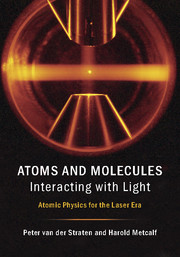Book contents
20 - Confinement of neutral atoms
from Part III - Applications
Published online by Cambridge University Press: 05 February 2016
Summary
In order to confine any object, it is necessary to exchange kinetic for potential energy in the trapping field, and in neutral atom traps, the potential energy must be stored as internal atomic energy. Thus practical traps for ground-state neutral atoms are necessarily very shallow compared with thermal energy because the energy level shifts that result from conveniently sized fields are typically considerably smaller than kBT, even for T = 1 K. Neutral atom trapping therefore depends on substantial cooling of a thermal atomic sample, and is often connected with the cooling process. In most practical cases, atoms are loaded from magneto-optical traps, where they have been efficiently accumulated and cooled to mK temperatures (see Sec. 20.3), or from optical molasses, where they have been optically cooled to μK temperatures (see Sec. 19.4).
The small depth of typical neutral atom traps dictates stringent vacuum requirements, because an atom cannot remain trapped after a collision with a thermal energy background gas molecule. Since these atoms are vulnerable targets for thermal energy background gas, the mean free time between collisions must exceed the desired trapping time. The cross-section for destructive collisions is quite large because even a gentle collision (i.e. large impact parameter) can impart enough energy to eject an atom from a trap. At pressure P sufficiently low to be of practical interest, the trapping time is ~(10-8/P) s, where P is in torr.
This chapter begins with a discussion of ordinary, single-center traps, but also considers arrays of traps. Such “optical lattices” are playing an increasingly important role in research in atomic physics, so discussion of their properties is an appropriate part of the education of a student of the subject.
Dipole force optical traps
Single-beam optical traps for two-level atoms
The simplest imaginable optical trap consists of a single, strongly focused Gaussian laser beam (see Fig. 20.1) [214, 215] whose intensity at the focus varies transversely with r as where is the beam waist size. Such a trap has a well-studied and important macroscopic classical analog in a phenomenon called optical tweezers (see App. 1.C) [216–218].
- Type
- Chapter
- Information
- Atoms and Molecules Interacting with LightAtomic Physics for the Laser Era, pp. 367 - 381Publisher: Cambridge University PressPrint publication year: 2016

